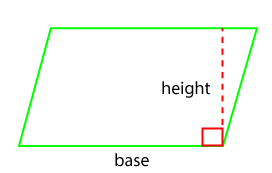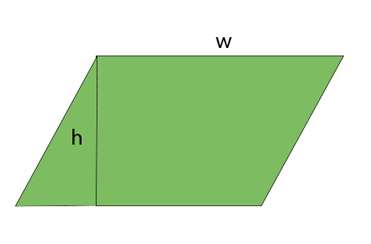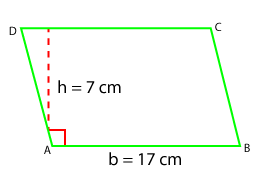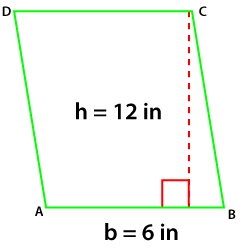Area of ParallelogramParallelogramA parallelogram is a quadrilateral (four sides) shape with two pairs of parallel lines. The opposite sides and congruent angles are equal in measure. The sum of the interior angles is 360°. The following shapes are special types of parallelogram:
Properties of Parallelogram
Area of Parallelogram FormulaTo find the area of parallelogram multiply the base by its height and vice versa. In other words, the area of a parallelogram is base times height. 
Note: The base and height should be perpendicular.
A = base (b) * height (h)
Where b is the length of the base, and h is the height of altitude. Note: We use the same formula to calculate the area of a parallelogram and a rectangle. The reason for using the same formula is that every parallelogram can be converted into a rectangular shape.Area of ParallelogramThe area of a parallelogram is the region covered by the parallelogram in the 2D plane. DerivationWe can derive the formula by using the following steps:
When we have done with all the above steps, it forms a rectangular shape. The area of the newly created rectangle will be the same as a parallelogram. 
Hence, the area of a parallelogram (A) is = b* h The parallelogram and rectangle have the same properties. So, the area of the parallelogram will be equal to the area of the rectangle. Let's see some examples and find the area of a parallelogram. Example 1: If the base of a parallelogram is 17 cm and height is 7 cm. Find the area. 
Solution: We have given b=17 cm and h=7 cm. We know that, Area of a parallelogram (A) = b * h A = 17 * 7 A = 119 cm2 The area of the parallelogram is 119 cm2. Example 2: Find the area of the parallelogram given below. 
Solution: From the above figure, b=6 cm. and h=12 cm. We know that, Area of a parallelogram (A) = b * h A = 6 * 12 A = 72 cm2 The area of parallelogram is 72 cm2. Area of a parallelogram when the height is not given We use trigonometry formula to find the area of a parallelogram if the height of the is not given in the question. Area of Parallelogram (A) = a * b sin (x) Where a and b are the length of parallel sides, and x is the angle between two sides. Example 3: The length of the parallel sides is 7 cm and 9 cm, respectively, and the angle between the sides is 90°. Find the area of the parallelogram. Solution: We have given, a = 7 cm., b = 9 cm. and x = We know that, Area of parallelogram (A) = a * b sin (x) A = 7 * 9 sin (90) A = 63 sin 90 A = 63 * 1 = 63 sq.cm. The area of the parallelogram is 63 sq. cm.
Next TopicArea of a Cylinder
|
 For Videos Join Our Youtube Channel: Join Now
For Videos Join Our Youtube Channel: Join Now
Feedback
- Send your Feedback to [email protected]
Help Others, Please Share









